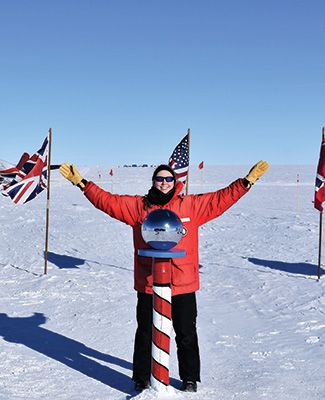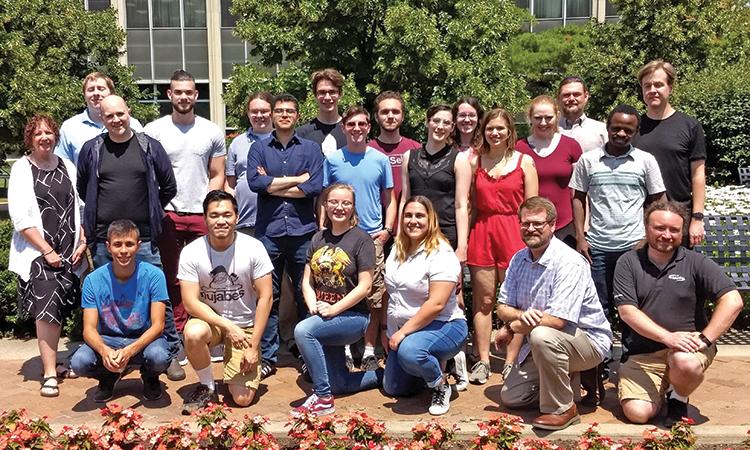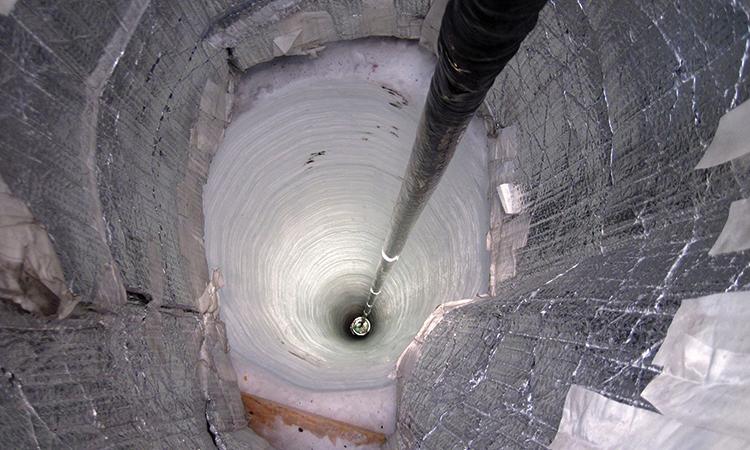Ghost Hunting in the Antarctic

Ghost Hunting in the Antarctic
MSU astrophysicists helping source cosmic rays from farthest reaches of universe
October 1, 2019On the frozen barrens of the South Pole—some 9,000 miles from East Lansing—MSU is helping lead a team of international scientists hunting “nature’s ghosts”—infinitesimally tiny subatomic particles called neutrinos.
One of 12 known particles from which our universe is assembled, neutrinos originate from violent astrophysical sources. In addition to our sun, think exploding stars, black holes and bursts of energetic explosions taking place in distant galaxies.
This field of study is known as multimessenger astrophysics. The National Science Foundation considers it one of the 10 big ideas worthy of future investments in science and engineering.
“There are about a billion neutrinos passing through every cubic centimeter of your body at this very moment,” said MSU’s Darren Grant, an astroparticle physicist and current spokesperson for the IceCube Neutrino Observatory, located at the Amundsen-Scott South Pole Station.
Neutrinos “interact so weakly with us that we don’t feel them. And so it takes extraordi-nary measures to detect them,” Grant added.
Here’s the drill: More than 5,000 highly perceptive optical sensors—each outfitted with photomultiplier tubes—are buried roughly two miles below just over a half-mile stretch of the region’s permanent ice cap.
They’re shielded from daylight and movement.
“What you have is a distributed grid of very sensitive light sensors,” Grant explained.
When neutrinos collide with other subatomic particles, they produce secondary particles that give off blue light.
When sensors detect extremely strong neutrinos, researchers convert the basic information into colored images of the neutrino interaction. Analysis is used to help determine the neutrinos’ intergalactic point sources.
Last year, “we captured a neutrino event that occurred four billion light years away off the shoulder of the constellation Orion,” Grant said. “‘It was the first compelling correlation ever of a high-energy neutrino from one of the most extreme astrophysical events in the universe.”
Astrophysicists worldwide believe the neutrinos were born in a blazar, thought to be a supermassive black hole that spews out gas, dust and even the stars it absorbs.
“We’re trying to piece together a cosmic puzzle,” Grant said with a smile. “It comes at a crucial time for the project as we look toward an exciting future of advancements in the field that the IceCube detector will provide.”
A BIG UPGRADE TO CAPTURE TINY NEUTRINOS
Nearly a decade after the completion of the IceCube Neutrino Observatory, steps are being taken to revamp and position the observatory for future discoveries.
The revamp, part of the long-term project nicknamed IceCube-Gen2, recently secured $23 million in funding from the National Science Foundation.
The total of new investment is expected to hit $37 million. The upgrade, to be installed in the 2022–2023 polar season, will add more than 700 of the most cutting-edge optical modules to the 5,160 existing sensors embedded in the ice.
Two new types of sensor modules, called Digital Optical Modules, will be tested for long-term use within IceCube-Gen2. The new sensor modules are two to three times more sensitive than contemporary detectors.
With the ability to track greater occurrences of neutrinos, scientists hope to put together more accurate models of neutrinos’ oscillation properties—which may explain how neutrinos transform when interacting with other particles during their journeys to Earth.
MSU will maintain its role as a key collaborator on the project and will contribute the cables, which are critical for linking optical modules beneath the ice to topside computers.
In addition, plans call for MSU to create a production facility where sensors, cables and other electronics will be produced and tested prior to deployment at the South Pole.
Learn more about the IceCube Neutrino Observatory.
Author: Alex Gillespie, '17









